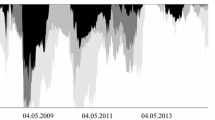Abstract
In this project, our topic pertains to examination of market efficiency, employing data from closed-end funds (CEFs) trading in the American stock market. Employing both aggregate and individual data, we examine whether or not moderate market performance is a sufficient condition in order to achieve abnormal returns, in the short-run, through exploitation of discount deviations from its mean value. The main hypothesis tested is that market performance affects the mean-reverting properties of CEFs’ discount. Moderate market performance ensures the mean-reversion of CEFs’ discount and points to cointegration between the share prices of CEFs and their net asset value (NAV). Furthermore, when NAV is identified as the common stochastic trend of the system then, market inefficiency is detected.
Similar content being viewed by others
Notes
Considering model specification, tables with lag length determination tests along with descriptive statistics and univariate normality tests for the residuals are available upon request.
In Table 6, considering results on CEFs numbered as 35 and 79, trace test indicates r = 1, however, due to residuals’ normality problems, we choose to accept r = 0. Examining, individual data, in order to secure robust results on cointegration rank and hypotheses tested, we have performed tests considering multivariate stationarity, univariate normality and variable exclusion. Tables reporting values on those tests are available upon request.
References
Anderson, S. (1986). Closed-end funds versus market efficiency. Journal of Portfolio Management, 13(1), 63–67.
Cakici, N., Tessitore, A., & Usmen, N. (2000). Closed-end equity funds: betting on discounts and premiums. Journal of Investing, 3(4), 83–92.
Cakici, N., Tessitore, A., & Usmen, N. (2002). Closed-end funds and turnover restrictions. Financial Analysts Journal, 58(3), 74–81.
Cha, H., & Lee, B. (2001). The market demand curve for common stocks: evidence from equity mutual fund flows. Journal of Financial and Quantitative Analysis, 36(2), 195–220.
Cheng, A., Copeland, L. S., & O’Hanlon, J. (1994). Investment trust discounts and abnormal returns: UK evidence. Journal of Business Finance and Accounting, 21(6), 813–831.
Chow, G. C. (1960). Tests of equality between sets of coefficients in two linear regressions. Econometrica, 28, 591–605.
Copeland, L. (2007). Arbitrage bounds and the time series properties of the discount on UK closed-end mutual funds. Journal of Business Finance and Accounting, 34(1–2), 313–330.
Dennis, J. G., Hansen, H., Johansen, S., & Juselius, K. (2005). CATS in RATS version 2, Estima.
Dimson, E., & Minio-Kozerski, C. (1999). Closed-end funds: a survey. Financial Markets, Institutions and Instruments, 8(2), 1–41.
Doornik, J. A., & Hansen, H. (1994). An omnibus test for univariate and multivariate normality. Working Paper, Nuffield College, Oxford.
Doornik, J. A. (1998). Approximations to the asymptotic distributions of cointegration tests. Journal of Economic Surveys, 12(5), 573–593.
Engle, R. F., & Granger, C. W. J. (1987). Cointegration and error correction: representation, estimation and testing. Econometrica, 55, 251–277.
Fabozzi, F. J., & Francis, J. C. (1977). Stability tests for alphas and betas over up and down market conditions. Journal of Finance, 32(4), 1093–1099.
Gasbarro, D., Johnson, R. D., & Zumwalt, K. J. (2003). Evidence on the mean-reverting tendencies of closed-end fund discounts. Financial Review, 38, 273–291.
Gemmill, G., & Thomas, D. C. (2002). Noise-trading, costly arbitrage, and asset prices: evidence from closed-end funds. Journal of Finance, 57(6), 2571–2594.
Gonzalo, J. (1994). Five alternative methods of estimating long-run equilibrium relationships. Journal of Econometrics, 60(1), 203–33.
Hamilton, J. D. (1994). Times series analysis. Princeton: Princeton University Press.
Johansen, S. (1988). Statistical analysis of cointegrating vectors. Journal of Economic Dynamics and Control, 12, 231–254.
Johansen, S., & Juselius, K. (1990). Maximum likelihood estimation and inference on cointegration—with applications to the demand for money. Oxford Bulletin of Economics and Statistics, 52, 169–210.
Johansen, S. (1996). Likelihood-based inference on cointegration in the vector autoregressive model. Oxford University Press.
Juselius, K., & MacDonald, R. (2003). International parity relationships between Germany and the United States: A joint modelling approach. Working Paper, FRU 2004/08, University of Copenhagen, Department of Economics (formerly Institute of Economics), Finance Research Unit.
Juselius, K. (2006). The cointegrated VAR model: Methodology and applications. Oxford University Press.
Kremers, J. J., Ericsson, N. R., & Dolado, J. J. (1992). The power of cointegration tests. Oxford Bulletin of Economics and Statistics, 54, 325–348.
Pontiff, J. (1995). Closed-end fund premia and returns: implications for financial market equilibrium. Journal of Financial Economics, 37, 341–370.
Sias, R., Starks, L., & Tinic, S. (2001). Is noise trader risk priced? Journal of Financial Research, 24(3), 311–329.
Thompson, R. (1978). The information content of discounts and premiums on closed-end fund shares. Journal of Financial Economics, 6(2/3), 151–186.
Author information
Authors and Affiliations
Corresponding author
Rights and permissions
About this article
Cite this article
Alexakis, C., Mavrakis, E. Is Moderate Market Performance in the U.S. a Sufficient Condition for Abnormal Returns on CEFs?. Int Adv Econ Res 16, 80–95 (2010). https://doi.org/10.1007/s11294-009-9245-4
Received:
Published:
Issue Date:
DOI: https://doi.org/10.1007/s11294-009-9245-4




